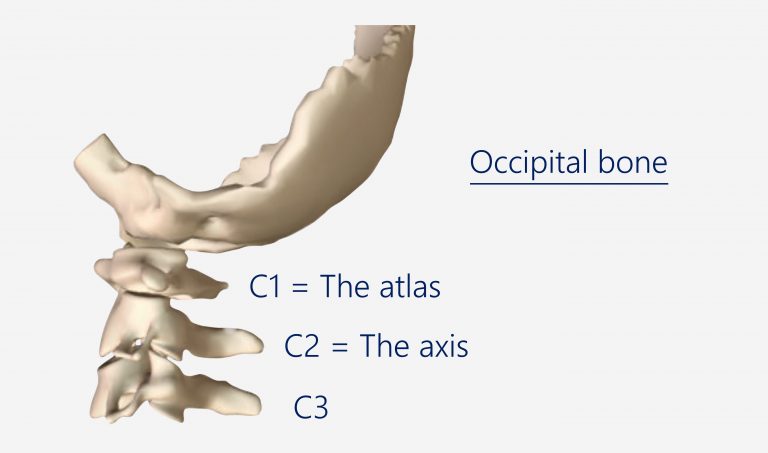Introduction – Anatomy of the neck
Collum means ‘neck’
Through a short summary of the anatomy of the neck, we can understand the structures which are important during the Collum treatment .

The cervical spine consists of seven vertebrae: C1 to C7. (C= abbreviation for Cervical)
We distinguish two zones here:
1. The AAO zone
The AAO-zone is an abbreviation for the Atlanto-Occipital zone, where Atlanto refers to the Atlas (C1), and Occipital refers to the Occiput (Latin for skull)
The first two cervical vertebrae, the Atlas and the Axis have functions that completely differ from the other vertebrae and are not interconnected by an intervertebral disc.
The Atlas bone (C1) is a bony ring with two cup-shaped joint surfaces on the top in which it carries the head (the head of an adult weighs about four to six kilos).
This first joint (the atlanto-occipital or cranio-cervical joint) is also being called the yes-joint : it allows for nodding yes .At the same time the shape of this joint blocks rotation. With this joint we succeed in nodding roughly 15 degrees forwards and backwards.
The Axis (C2) has a tooth (Latin : dens) which is positioned in the front of the atlas ring, and two joint surfaces with the Atlas.
This structure represents the second joint of the (neck) spinal column and enables rotations to the left and to the right up to 45 degrees. This is the no-joint. Forward and backward movements are very limited here.
The third cervical vertebra (C3) is connected with the Axis (C2) via an intervertebral disc, and clearly allows for extra movements of the yes- and no-joint. Therefore it belongs (more than the following four cervical vertebrae) with the first two cervical vertebrae. In this way C1,C2,C3 and the joint of C1 with the skull together form the AAO area of the cervical spine.
2. The cervical vertebrae C4 to C7
The cervical vertebrae C4, C5, C6 en C7 look – in shape and function- very much like the other vertebrae of the spinal column.
The spinal cord:
Inside the vertebrae there is the passage for the spinal cord, and normal movements are no hindrance for this. Same for the blood supply which flows through the openings in the transverse processes of the cervical vertebrae.